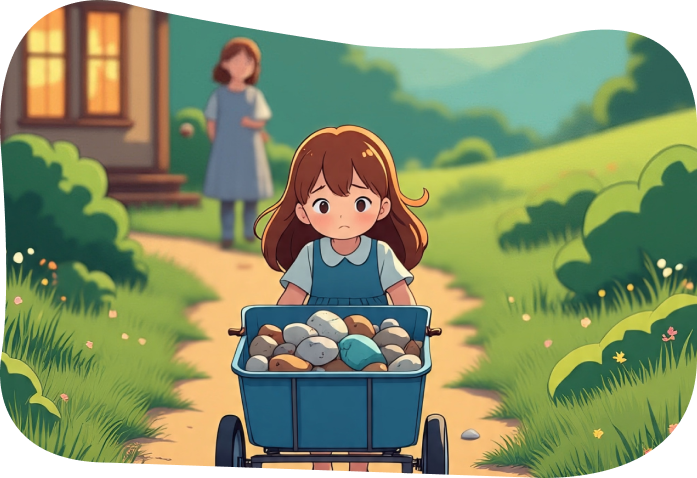
Worry doesn’t always look like pacing in the hallway or sitting with your head in your hands. Sometimes, it looks like a quiet mother, tired after a long day, gently pushing aside her daughter’s excitement. It’s in the sigh, the silence, the “maybe later.” In Karen R. Sullivan’s heartfelt children’s book The Blue Wagon, a simple story about rocks and a wagon turns into a deep reflection on the unseen burdens we all carry—especially worry. This isn’t just a children’s tale. It’s a soft whisper to adults who’ve forgotten how heavy life has become until someone points it out.
At the center of the story is Heather, a six-year-old girl on a treasure hunt with her beloved blue wagon. She collects rocks—each one different, each one special. There’s a shiny crystal-filled rock, a round marbled one, and even a colorful “pet rock” gifted to her by Mr. Wiggledimp, a gentle old man who shares a piece of his past with her. As Heather’s wagon fills with rocks, something begins to change. The joy of collecting shifts into weariness. The excitement fades just enough for her to feel tired, to sit, to wonder why pulling her wagon suddenly feels harder. This is where the deeper meaning begins.
When Heather finally returns home, she’s exhausted. Her mother, busy preparing dinner, tells her to wash up and wait. Heather listens, though she’s disappointed. Eventually, her mother joins her, and they walk to the shed to look at her treasures. There, in the warmest moment of the book, her mother explains something Heather had started to feel but couldn’t name: “Sometimes grown-ups don’t pull wagons, but they pull thoughts out of their heads. And those thoughts get heavy just like your rocks.” In that one line, The Blue Wagon quietly names something we all experience—worry. A burden without shape or color, yet one that can weigh us down more than any stone.
Worry isn’t loud. It doesn’t always announce itself. It slips in slowly and settles quietly. A parent worried about bills. A teacher carrying the heartbreak of a student. A caregiver unsure they’re doing enough. A child wondering why their grown-up can’t play today. Heather’s mother doesn’t speak much about her own worries, but her tired eyes and delayed response say enough. Sullivan shows us this not to blame her, but to humanize her. Even the most loving, attentive parent can be worn down by worry. Through this, The Blue Wagon offers an invitation—not just to recognize the weight of our own rocks, but to pause and consider which ones we’ve been carrying for too long.
What makes this book powerful is its layered storytelling. On one level, it’s about a child learning that burdens exist. On another, it’s about a parent realizing that some lessons, like worry, are passed down whether we mean to or not. Heather’s understanding begins when her mother opens up. But it’s not a fearful, anxious conversation. It’s a calm moment of honesty—a moment that respects the child’s ability to understand without being overwhelmed. This mirrors the knowledge from the author’s own reflections in her questionnaire. Karen R. Sullivan emphasized the importance of not overlooking children. That they should be noticed—not just seen. This moment in the book embodies that perfectly: Heather is not brushed aside or babied. She’s spoken to with truth and tenderness.
Another key figure in Heather’s day is Mr. Wiggledimp. He’s cheerful, kind, and deeply present. When Heather tells him about her treasure hunt, he listens. He even goes back into his house and gives her one of his childhood treasures—a painted rock that once meant everything to him. In giving Heather the rock, Mr. Wiggledimp also gives her something more: time, attention, and validation. This gentle interaction is one of Sullivan’s most meaningful illustrations of emotional kindness. As she noted, this book carries spiritual teachings—though not overtly religious, they show up in moments of wisdom, compassion, and care. Mr. Wiggledimp doesn’t offer a solution to worry, but he models something just as powerful: being present.
By the time the story ends, Heather has learned a lesson many adults haven’t yet fully embraced: the things we carry—both seen and unseen—can change the way we move through the world. And that’s what The Blue Wagon ultimately leaves us with: a reflection of our own wagons. What rocks are in yours? The worry that you’re not enough? The anxiety about tomorrow? The regret from years ago? The pressure to do more, be more, carry more? Heather didn’t discard her treasures. She didn’t regret picking them up. But she did recognize that carrying them made her tired—and she rested. And that may be the quietest, most healing message of all: it’s okay to rest. It’s okay to acknowledge that worry is heavy. It’s okay to be honest with our children—and ourselves—about it.
Karen R. Sullivan has written a story that speaks gently, but powerfully. It’s for children, yes—but also for the parents reading beside them. The story is simple, the language clear, but the message is greatly emotional. As the author shared, this book is for the adult inner child too. Because worry doesn’t start in adulthood—it often begins when we’re young, picking up rocks we didn’t know were heavy.
Quick Links
Useful Links
Copyright © 2025 Karen Sullivan. All Rights Reserved.